Human Model
The Total HUman Model for Safety (THUMSTM) is a computational model of the human body and can be used to investigate the human body in various impact scenarios. It is actively developed by Toyota Motor Corporation and Toyota Central R&D Labs since approximately 2000 and thus, model updates are provided regularly. In Germany, the THUMS model is commercially distributed by DYNAmore. It is also possible to obtain a non-commercial license, strictly limited to universities and research institutes.
The THUMS model is currently available in two different variants
(see Figure 1)
- a 50 percentile male occupant model (AM50) and
- a 50 percentile male pedestrian model (AM50).
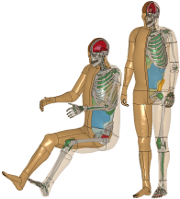 Figure 1: occupant and pedstrian THUMS models
Figure 1: occupant and pedstrian THUMS models
Additionally, three different versions are available (cf. Figure 2)
- Model Version 1.4/1.6
This version was developed in 2003/2004. It represents a kinematical human model, reflecting the skeleton, joints, flesh/muscle/fat, simplified organs and a simplified head model. - Model Version 3.0
Version 3.0 was developed in 2008 and contains a heavily refined head model, based on CT scan images. Also various model materials have been adapted and the geometry has been slightly improved. - Model Version 4.0
Version 4.0 reflects the current version and was released in the end of 2010. It represents a heavily refined model using approx. 2mio elements. New developments are the very fine internal organ modelling, 3D ligaments and improved materials. The model geometry is entirely created based on CT scan data.
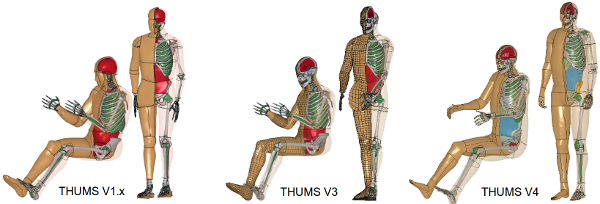
Figure 2: Comparision between model versions 1.x, 3.0 and 4.0
The THUMS models generally reproduce the anatomical geometry and the biomechanical properties of the human body, for instance the skeletal structure, the joints, the bone stiffness or the skin flexibility. Its main applications are the simulation of the kinematics of the human body in occupant and pedestrian safety simulations or the evaluations of stresses and strains within the bones and joints. Based on a heavily refined modelling technique, newer model versions (version 4) also enable deeper analyses, e.g. of injury mechanisms.
The 50%-ile adult male (AM50) model represents an average adult with a height of 178.6cm and a weight of 77.3kg, thus leading to a BMI (body mass index) of about 25. The element size of the model version 4.0 is approximately 3-5mm with a total number of 1.8 million elements and about 630,000 nodes. The model mainly consists of solid (hexa- and tetra meshing) and shell elements. Discrete and beam elements are also used to model connections like tendons, ligaments and also (passive) muscles.
For the occupant model, the following table provides some general information about the more recent versions 3.0 and 4.0. The pedestrian model shows similar properties
| THUMS occupant models | THUMS V3.0 | THUMS V4.0 |
|---|---|---|
| parts | 1.576 | 1.273 |
| Nodes | 104.489 | 628.358 |
elements
| 143.044 118,484 24,560 | 1.755.284 1.749.575 5.709 |
contacts
| 220 30 190 | 19 |
| initial time step size | 3.88e-4ms | 1.45e-4ms |
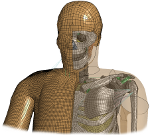
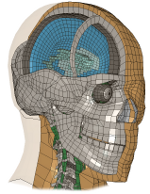
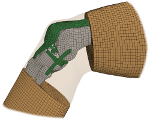
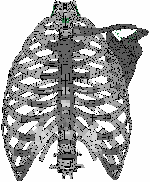
Figure 3: Details of the THUMS human model, Version 4.0.
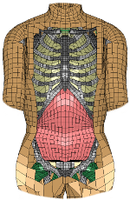
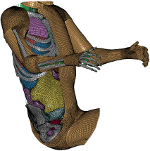
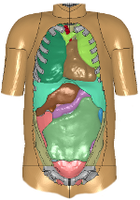

Figure 4: Details of the internal organs (left) model version 3.0, (right) model version 4.0.
Typical applications for the pedestrian model variant are for instance pedestrian safety simulations, for instance to investigate the impact time and location of the head on the vehicle bonnet. Here the model can easily be repositioned and various step postures or stances can be used to reflect differences in the overall kinematical behaviours.
Recently, additional interest arose in the THUMS family, where different model sizes are adopted to reflect possible differences between various sizes of the human body, e.g. 5%-ile adult female (AF05), 6 year old child model (6YO) or the 95%-ile adult male (AM95). Figure 5 shows the three models AM50, AF05 and 6YO and a size comparison using an example vehicle (Geo metro model - http://www.ncac.gwu.edu). Figure 6 additionally shows an example of a frontal impact scenario using the AM50 THUMS model and the Geo metro model.
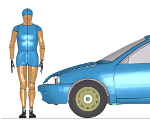
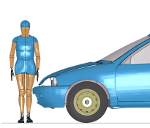
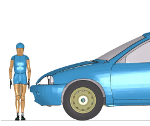
Figure 5: The THUMS family including the AM50, AF05 and 6YO model.

Figure 6: AM50 THUMS pedestrian model in a frontal impact scenario.
The occupant model variant represents a 50%ile adult male in a seated position. It can mainly be used for occupant simulations, e.g. belt or airbag development or for kinematical evaluations for various crash scenarios, including frontal, lateral and rear impact situations. Figure 7 shows the kinematical behaviour of the THUMS model in a frontal crash test using a seat belt.

Figure 7: AM50 THUMS occupant model in a frontal impact using seatbelt restraints (courtesy of Daimler AG).
Please contact DYNAmore to get more information about the model licensing and pricing.